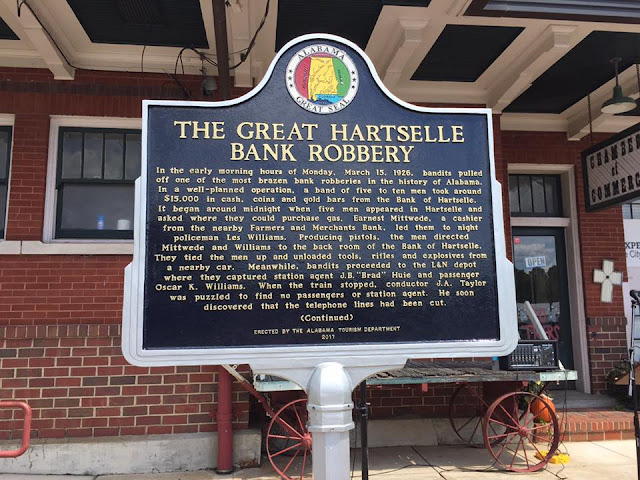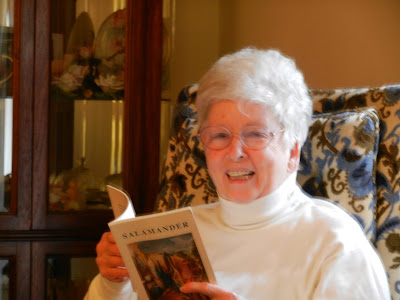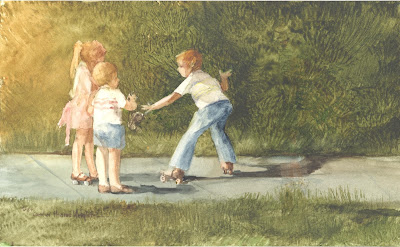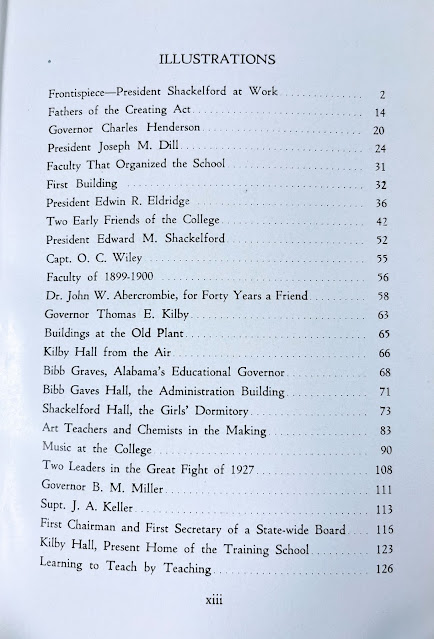I've done several posts on this blog about my mother Carolyn Shores Wright and her activities. One item covered her high school modeling stint for Avondale Mills. Her career as a professional artist, mostly in watercolor, lasted almost fifty years. I've written about the time she heard George Washington Carver speak in Camp Hill when she was seven years old. I've also covered the 1950 Auburn football game my parents attended soon after their wedding, and a bit about the Jefferson County town where she was born, Powhatan.
Mom died on January 17, so I wanted to do a tribute to her on this blog. I've included the text of her obituary, since it covers the highlights. Also in this post are some photos of her and family and some images of her art to give an idea of the variety of subjects she painted.
More comments are below some of the photos and images.
Carolyn
Shores Wright December 28, 1929-January 17, 2023
Carolyn Shores Wright, 93, of Huntsville, AL passed away
peacefully at home Tuesday, January 17. She was born in Powhatan, a west Jefferson
County coal mining town that no longer exists. Carolyn and her siblings were
the children of long-time Methodist
minister John Miller Shores, and they lived in various towns including Camp
Hill, Florence, Sylacauga, Alex City, and Montevallo. One of her vivid memories
from childhood was hearing George Washington Carver speak in Camp Hill when she
was about 7 years old. During high school, Carolyn was a model for Avondale
Mills. She attended college at Montevallo and Auburn, where she met her husband
of 52 years, A.J. The passions of her
adult life were family, her church and her painting. She and A.J. were founding
members of Aldersgate United Methodist Church in Huntsville. For about fifty
years Carolyn was a very prolific artist, first in oils, then acrylics, and
finally “her medium” as she described it, watercolors. During those years she
created hundreds of works that featured hummingbirds and many other birds,
flowers, still lifes, landscapes, people and a series of humorous and whimsical
bird paintings she called “Bird Life.” Carolyn was preceded in death by husband
Amos Jasper Wright, Jr.; her mother Tempe Flowers Shores and father John Miller
Shores; step-mother Edith Shores; sister Hethie Shores Kuehlthau; sister
Marjorie Shores Pike; and brother John Miller Shores, Jr. She is survived by
her sons Amos Jasper Wright III [Dianne] and Richard Ashley Wright [Lucy]; brother
Max Shores [Cindy]; grandchildren Amos Jasper Wright IV [Kim], Ashley T. Wright
[Jessica], Becca Wright; and Miller S. Wright [Kathyrn]; and
great-grandchildren Ann Collins Wright, Ashley McDonald Wright, and Ezra Jasper
Leon. Also surviving are two special nieces Charlotte Shores Ryder [Curtis] and
Cindi Shores Sherrill, as well as many other nieces and nephews. Visitation
will be held Saturday, February 4, at 11 A.M. at Aldersgate United Methodist
Church in Huntsville, with service to follow at noon. Internment will be in
Maple Hill Cemetery in a private family service. In lieu of flowers memorials
to Aldersgate United Methodist Church (Honduran Mission) or the Alabama
Sheriffs Youth Ranches would be appreciated.

Mom is between sisters Marjorie and Hethie and with brother John.
Mom again in the middle between Marjorie and Hethie many years earlier.
My grandmother Tempe Flowers Shores and her children. Hethie is standing, then Marjorie, mom and John.
Mom and dad are flanking my paternal grandparents at their house on Chandler Street in Gadsden. Richard and I are on the floor. I'm really excited over the white socks I'm wearing. The occasion was the fiftieth wedding anniversary of Rosa Mae and Amos Wright; they were married on Halloween 1915.
Dad and mom on a Christmas trip to Gatlinburg.
Mom's parents and siblings are in this photo; mom wasn't around yet. Her father John Miller Shores was a minister in the North Alabama Conference of the United Methodist Church for several decades.
Dad and mom and the wedding cake at the First Methodist Church in Haleyville, 10 September 1950.
Mom and my children, Becca and Amos
Mom with my younger brother Richard and his sons Ashley and Miller. Mom was in her red hair phase; the red hat phase came later.
A formal family portrait in the late 1950's. Mom always wanted me to digitize this photo and take her out; she was not fond of the hairdo.
Yours truly, mom and brother Richard on the steps of our house on Cloverdale Drive in Huntsville in the mid-1950s. The three of us revisited the house in July 2018.
Richard and mom walking toward dad's grave in Maple Hill Cemetery. That spring 2022 visit was the last time we took her there.
"Spring Fantasy"
"Fancy Flight"
"A Brother's Trick"
Mom said this painting was suggested by her brother John--he would roller skate really fast up to his sisters and turn away just in time...
"Holiday Cruise"
Mom did a number of paintings in what she called her "Bird Life" series that featured birds in human situations. You can see more of them here.
























.jpg)

.jpg)

.jpg)


.jpg)
.jpg)
























